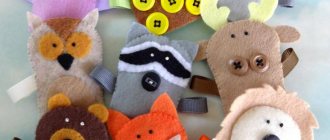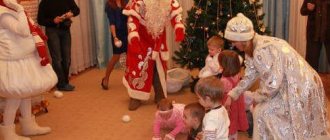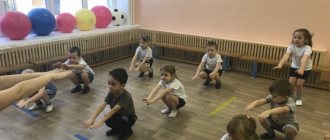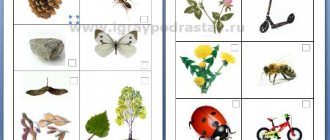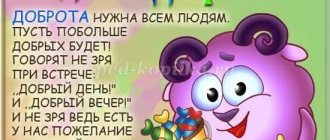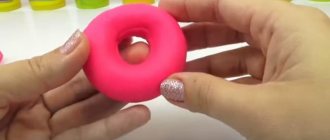MAGAZINE Preschooler.RF
Methodological development "Children's Book Day"Interactive leisure for children of senior preschool age
Neustupova Ekaterina Sergeevna, senior teacher, kindergarten No. 6, Kalininsky district of St. Petersburg
Goal: to bring joy, create a cheerful festive mood, indicate the significance of a book in a person’s life, the indispensability of a book in the socio-cultural development of people,
Tasks:
Educational:
- give knowledge about this holiday, the history of the book
- consolidate knowledge about children's writers and poets
Educational:
- promote the formation of interest in books and works of fiction.
- show children the social significance of the holiday - Children's Book Day
- develop elements of creativity, teach how to use what you read in other types of activities (play, productive, communication)
- develop independence and initiative, artistic and aesthetic taste
- give information about the importance of reading fiction books
Educational:
- To develop the ability to listen and understand works of different genres, to express emotions.
- cultivate neatness, friendliness and a caring and careful attitude towards books
Technologies used: ICT,
Materials and equipment: media projector with presentation, books, plasticine and stacks for children, visual materials, paper, birch bark, stone, clay, thin planks, wax, alcohol lamp for heating wax, cords or ropes for making books.
Leisure progress: slide 1
Host: Hello, guys! Today we will talk about the book. What is a book? Why do people need books? Do the animal world need books? (Children's answers)
slide 2
Host: That's right, guys, only a person needs books to learn something new, to know everything about everything in the world. (Reads a poem)
Guys, what proverbs or sayings do you know about books? (Children's answers)
Host: Do you know that books weren’t always the way they are now? What do you think books are made of? (Children's answers)
Presenter: The history of the book has its roots in the distant past. Different peoples came to writing in different ways, using different materials for writing: stone, bone, wood, metal, silk, leather, corn stalks. (The presenter talks from the slides)
slide 3-8
In ancient times, the material for writing was STONE. The first drawings by primitive artists were found on the walls of caves. Subsequently, laws, names of kings, and memorable events were carved on rocks, stone tiles and pillars.
Then CLAY BOOKS appeared - the most ancient. On the still soft and wet clay, words-icons were squeezed out with a sharp stick. Then the board was dried and fired in ovens, like pots. The clay tiles were 32x32 cm in size and 2.5 cm thick - real flat bricks. A book was created from a dozen, and sometimes hundreds of such pages. Such books were written in the ancient states of Mesopotamia and Assyria.
And in the neighboring Egyptian state, books were made from PAPYRUS - a river reed with a tall and thick trunk, cut into strips and dried. They wrote on them with sticks, dipping them in ink or colored paints. Then the sheets were glued together to form a book in the form of a long scroll. Usually about 6 m long. After reading, the scroll was rolled into a tube and stored in a special case.
Papyrus was replaced by a new writing material - PARCHMENT.
In the ancient Pergamon state it was made from animal skins. It could be written on both sides. A sheet of parchment was folded in half to make four pages. The quarter in Greek was called “tetrados” , and all together they made up a notebook. Several of these notebooks were stitched together to form a book in which one could write and draw, and it was called a codex. In appearance, the codex resembles a modern book. It took a whole flock of sheep to write one book. The book was written by hand over several years.
In Ancient Rus' they wrote on birch bark - BERESTA. Marks were made on the bark using a bone rod with an eye at the top, through which a ribbon was pulled. The rod was hung from the belt.
In the 2nd century. e. PAPER was invented in China. It was cheaper material. Paper was invented by Cai Lun. He found a way to make paper from the fibrous inner bark of the mulberry tree. The Chinese learned to grind the bark in water to separate the fibers, then they poured the mixture onto trays with long, narrow strips of bamboo at the bottom. When the water drained, the soft sheets were laid to dry on a flat surface. Bamboo and old rags were used for this purpose. The Chinese kept the secret of paper production for 800 years. No writing material has received such recognition as paper.
In different countries, entire workshops for publishing books began to be created. This work was considered very important and honorable. The first creators of handwritten books were monks. The scribe wrote out letter by letter, line by line. And the artists filled the pages with drawings. The title was written in a whimsical stroke. Then the book was “dressed” in binding, decorated with silver and precious stones. The books were true works of art.
Host: Guys, would you like to make a book yourself?
— The wooden book appeared around the 1st century AD. It was made like this: melted wax was poured onto the pages - tablets and, while it was soft, they smoothed it out. They wrote on the hardened wax with a sharp stick. Several planks were connected with a cord into a book.
Now we will try to make such a book.
(The presenter and a group of children make a book on their own.)
Slide 9-10
First printing press
Johann Gutenberg, a German master, opened a new era in book publishing by inventing the first printing press. In less than a year, 300 books of the Bible were printed, and previously it took up to 10 years to copy a book.
In 1563, Tsar Ivan the Terrible established the first state printing house in Moscow and the first Russian printed books were created by Ivan Fedorov, a deacon of the Church of St. Nicholas of Gostuzhsky and his associate Peter Timofeevich Mstislavets. In Moscow, near the wall of Kitai-Gorod, where the first Printing Yard was located, there is a monument to Ivan Fedorov.
The first Russian printed book
On March 1, 1564, the first Russian printed book “Apostle”
Slide 11
Presenter: Guys, look at what complex modern printing presses they use to make books nowadays.
Slide 12
Host: Please answer, what can be made from plain paper?
Slide 13- 18
Presenter: Now, guys, look at what extraordinary books there are in the world.
— The Golden Book was discovered by American archaeologists conducting excavations in Sri Lanka. Its pages are made of pure gold. The text of one of the ancient Indian poems is engraved on the precious sheets.
— A blacksmith from the Bulgarian village of Vratsa, Angel Kostov, made a metal book weighing 4 kg, format 18x22 cm. On its twenty-two pages there are world-famous Gabrov jokes, aphorisms and proverbs.
— The most expensive book in the world is now considered to be ’s Bible , published in 1455. For one copy of it, printed on parchment, the American Wallber paid $350,000 in 1926. Now it is in Washington, in the Library of Congress.
The biggest book
This book contains 37 printed maps, which were published in 1660 especially for the English king of that time, Charles II. These 37 images of the Earth immortalize absolutely all the knowledge and ideas of humanity of that time about the world. The book has been studied by historians more than once; it contains a wealth of data about that time. All atlases are, in fact, wall maps, measuring 1.9 x 1.75, which were neatly bound and richly decorated.
Slide 19
Host: And now, guys, we would like to hear what poems about books you know. (Children read poetry)
Slide 20- 25
Host: Which children's writers and poets and what of their works do you know?
A.Barto
Slide 26
Let's play a little. You are given a task: remember the name of a fairy tale based on its hero.
Slide 27-29
The presenter takes out a book without pictures and with colorful illustrations and shows it to the children.
Guys, how are these books different? (Children's answers). That's right, this book has colorful pictures. Who draws pictures in books? Yes, that's right, illustrators. What illustrators do you know?
Stories from slides.
Slide 30
Host: Now guys, compare these two books. Shows an old, torn book and a new one. How are these books different? (Children's answers) That's right, guys. And in order for books to remain new and beautiful for a long time, there are rules for handling books. Do you know them? Slide story.
Slide 31
Host: Tell me, guys, what kind of premises are these? That's right, such rooms are called libraries. The word “library” comes from the words “biblio” - book, and “teka” - storage. That is, a library is a repository of books. What are libraries for? (Children's answers). That's right, guys, you can borrow a book from the library to read it. After all, we read a lot throughout our lives and we are not able to keep all the books we read at home. That's why people create libraries and use them.
Slide 32- 33
Host: And now, guys, I will introduce you to monuments dedicated to books and reading. Next on the slides.
Slide 34
Host: Now let’s try to solve a crossword puzzle about books and reading. Let's find out how you listened and what you learned from our conversation today.
- word: What material did they write on with sharp sticks attached to a belt in the old days in Rus'? (Birch bark)
- word: Children's writer who wrote funny stories about Dunno? Nikolai... (Nosov)
- word: The best teaching is... (Reading)
- word: Book storage (Library)
- word: Surname of the first Russian book printer (Fedorov)
- word: Children's writer who wrote a series of poems about toys. (Barto)
- word: The material from which books are made. (Paper)
- word: Our best friends for life are - (books) MUSIC (TOUCH)
Well done guys, you solved the whole crossword puzzle. This means you know how to listen carefully and remember what you hear.
Slide 35
Presenter: Now, at the end of our holiday today, the guys will sing us a song about books
Then the presenter reads a poem
Competition “COLLECT A PROVERB”
- Bread nourishes the body, just as you fly on wings.
- Gold is mined from the earth and attracts people to it.
- Illiterate is like a blind man, but a book is intelligence.
- The book decorates with happiness, gain your mind.
- A book is not a carrot, but a book opens your eyes.
- A book is not an airplane, it shines brighter than a star.
- A good book, but misfortune is a comfort.
- Knowing a book will take you far away.
- You read a book and knowledge comes from books.
Competition “COLLECT A PROVERB”
- Bread nourishes the body, and a book nourishes the mind.
- Gold comes from the earth, and knowledge comes from books.
- Illiterate is like a blind man, but a book opens his eyes.
- The book decorates in happiness, and consoles in misfortune.
- The book is not a carrot, but beckons.
- The book is not a plane, but will take you far away.
- A good book shines brighter than a star.
- Knowing a book means gaining intelligence.
- Reading a book is like flying with wings.
Application:
materials that can be additionally used during leisure time:
How good it is to be able to read! No need to pester your mother, no need to shake your grandmother: “Read, please! Read it!”
There is no need to beg your sister: “Well, read another page . No need to call, No need to wait,
Or you can take it and read it! Book Festival The snow is melting, the waters are bubbling,
The birds are calling loudly. The children's eyes are blooming like spring today. They love holiday books very much
Both girls and boys. The Book is faithful, the Book is first, the Book is the best friend of the guys.
We can't live without a book, We can't live without a book! - All the guys are talking.
(Z. Bychkov)
Writer
We are all friends with books: Both you and I are readers. And, of course, we know what their writers write.
It’s not easy to become a writer, Just like a musician, you definitely have to have talent.
Like any profession, It has its own secrets: The hero acts in the book Strictly according to the plot.
The author composes his story while sitting in a chair. There is no limit to invention - If only it were more interesting.
He will send Dunno to the moon, like a magician, and make him fall in love with a magical country.
From it they come to us: Winnie the Pooh, Malvina, Aibolit, Hippopotamus, Brave Chippolino.
Here, at the desk, the place of their birth, All their adventures come to life under the pen.
Now the line has been completed, And the book is ready... Girls and boys will probably read it!
Reading
Mom reads me a book about a bunny and a little fox... I would listen to about the war, but mom is a girl.
She will probably be bored, so much so that she even yawns. Okay, tomorrow about the war. Dad will read it at night.
And today about a bunny and a teddy bear. Whether it’s about a mouse, or even about a cone – It wouldn’t matter if there was a book!
(A. Kornilov)
Book secrets
If you want to know a lot, listen to advice. Learn to recognize Book secrets.
Each book has its own secret, And there are no unnecessary books. If a fast plane rushes into the sky,
The pilot knows his secret. He studied it. Each book has its own secret, And there are no unnecessary books.
If mom cooks cabbage soup and porridge for lunch, she has her own secret, also very important.
Know, all girls, Know, all boys: Every book has its own secret! Read books everyone!
(L. Guselnikova)
- **
A good book, my companion, my friend, Leisure time can be interesting with you. We are having a great time together and we are slowly carrying on our conversation.
You tell me about the deeds of daredevils, About the secrets of the Earth and the movement of the planets - There is nothing incomprehensible with you. You teach to be truthful and valiant,
To understand and love nature, people. I cherish you, I take care of you, I cannot live without a good book.
(B. Raevsky)
| Next > |
Competition winners:
Book “The Tale of a Wild Cat in a Big City”
A literary and artistic work for primary school age.
Completed by students of the 1st "E" class of GBOU school 471 of the Vyborg district of St. Petersburg, the leader is primary school teacher Elena Gennadievna Rudkovskaya. Help in designing the book from parents Khomenko O., Sidorova M. The book is 28 pages, made in A-4 format, the sheets are laminated.
All book spreads are here.
The prize is a set of books “A House for Foxes.”
***
Trofimova Polina, 7 years old. "Book "01".
Club association for sewing “Modnitsa” MOBU DO DDT “Rainbow”, Sterlitamak district, Republic of Bashkortostan. Head: additional education teacher Maria Viktorovna Spevak. The fire safety book “01” is made of fabric. The book's illustrations are made using fabric appliqué technique.
The prize is a set of books “Whose Side?”
***
